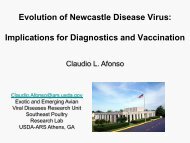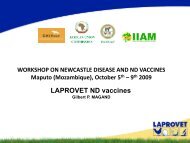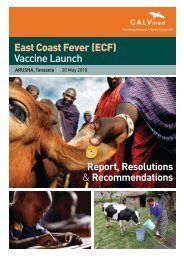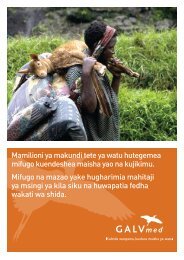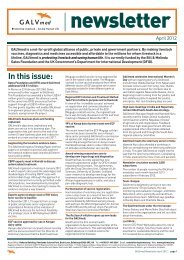A Path to Prosperity New Directions for African Livestock
GALVmed Impetus Strategy Paper
GALVmed Impetus Strategy Paper
- No tags were found...
Create successful ePaper yourself
Turn your PDF publications into a flip-book with our unique Google optimized e-Paper software.
<strong>African</strong> Development Bank<br />
The <strong>African</strong> Development Bank (AfDB) is another<br />
important player in <strong>African</strong> agriculture, by providing<br />
loans and grants <strong>to</strong> <strong>African</strong> governments and private<br />
companies investing in member countries. Since its<br />
establishment in 1964, the Bank has financed 2,885<br />
operations, <strong>for</strong> a <strong>to</strong>tal of US$47.5 billion. In 2003, it<br />
received an AAA rating from the major financial<br />
rating agencies and had a capital of US$32 billion.<br />
The infrastructure sec<strong>to</strong>r has traditionally received<br />
the largest share of AfDB lending and remains a key<br />
component of agricultural development. The Bank’s<br />
Agriculture Sec<strong>to</strong>r Strategy 2010–2014 provides an<br />
excellent analysis of the challenges facing Africa in<br />
terms of meeting its food security needs. The Bank<br />
states that “at current rates, it is estimated that<br />
Africa will be able <strong>to</strong> feed less than half its population<br />
by 2015.” The bank is fully committed <strong>to</strong> working in<br />
tandem with CAADP by building partnerships based<br />
on complementarity, comparative advantage and<br />
specialization in two key areas:<br />
i) improving rural infrastructure, including water<br />
management and s<strong>to</strong>rage, and trade-related<br />
capacities <strong>for</strong> access <strong>to</strong> local and regional<br />
markets; and<br />
ii) extending the area that is being sustainably<br />
managed <strong>to</strong> improve the resilience of the natural<br />
resource base, and thereby protect investments.<br />
The Bank’s President, Donald Kaberuka, recently<br />
summed up the challenges facing <strong>African</strong><br />
agriculture: 137<br />
“two years ago, in 2008, the food price hikes<br />
demonstrated our vulnerabilities <strong>to</strong> shifts in the<br />
structure of world demand and supply <strong>for</strong> food.<br />
It has since abated somewhat, but the problem<br />
has not gone away.<br />
The <strong>African</strong> Development Bank has, at all times,<br />
been a major player in agriculture, even when other<br />
partners downsized their portfolios. Today we<br />
continue <strong>to</strong> play our part, especially in irrigation<br />
and water management, where we have first-class<br />
experience. But our Continent remains food insecure,<br />
even though our farmers work harder and longer<br />
hours than their counterparts elsewhere. Analyses<br />
as <strong>to</strong> what went wrong, and what <strong>to</strong> do is common<br />
knowledge. The science is available. It is true, in the<br />
past years, dis<strong>to</strong>rted macro-economic policies and an<br />
overbearing State depressed farmers' income.<br />
But that was corrected. But, paradoxically, what<br />
constituted a problem then, may now be part of the<br />
solution. Fast urbanization across the continent, and<br />
the dis<strong>to</strong>rting policies now corrected, offer unique<br />
opportunities <strong>to</strong> the farmer. The terms of trade have<br />
shifted in favour of the farming world. So what is<br />
missing? The State.<br />
CAADP, Africa’s agriculture plan, has spelled out the<br />
whys and how. Many Governments are coming<br />
<strong>for</strong>ward with national plans. Time is now ripe <strong>for</strong> the<br />
state <strong>to</strong> again firmly step in <strong>to</strong> provide the farming<br />
sec<strong>to</strong>r the level of support it now needs. Yes, it is<br />
roads, irrigation – it’s finance, research and extension<br />
services, and yes, why not targeted, exit-timed<br />
subsidies <strong>for</strong> inputs and fertilizers? The nature and<br />
vehicle of delivery of such state support will of course,<br />
be country specific. But in scaling up that state<br />
support, we must be aware of major shortcomings of<br />
the past; <strong>for</strong> donors; the inadequate division of labour<br />
among IFIs. For Governments, governance issues in<br />
parastatals which were meant <strong>to</strong> support but ended<br />
up stifling agriculture. And <strong>for</strong> all of us? The biggest<br />
shortcoming of all? The inadequate attention that was<br />
given <strong>to</strong> the majority of farmers, the women farmers,<br />
<strong>to</strong> gain higher productivity, access <strong>to</strong> finance, move up<br />
the value chain, and run viable agricultural SMEs<br />
alongside the menfolk. Food security will not be<br />
possible – gains in agricultural productivity is unlikely,<br />
unless gender is put at the center of a modernized<br />
agriculture. We have learnt this at our expense, but it<br />
can now be corrected. At the same time, as we<br />
remobilize <strong>for</strong> agriculture, our continent is getting<br />
hotter and drier, rains more unreliable due <strong>to</strong> climate<br />
change.”<br />
The Impetus Strategy Paper I Page 55



